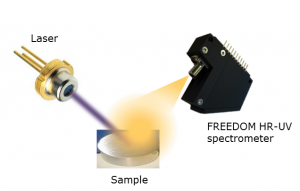– a Necessity for Your LIBS Instrument
Laser Induced Breakdown Spectroscopy (LIBS) is an extremely versatile spectroscopic technique that can be used to analyze the atomic composition of virtually any material. In a LIBS system, a short laser pulse is used to ablate material from the surface of a sample. The laser pulse energy will be high enough to create bright plasma on the surface of the sample.
When choosing a spectrometer for your LIBS application there are various parameters that are important, depending on your requirements. Ibsen believes that the 3 following features are among some of the most important parameters:
Short and precise trigger delay
Why are light sensitivity and light throughput important?
A high-throughput spectrometer allows a lot of light to be directed onto the detector. When coupled with high sensitivity detectors that efficiently convert this light to an electrical signal, it is possible to perform individual measurements of each laser shot, each of which results only in a finite amount of characteristic light from the elements in the sample. These are useful features when trying to separate the signal from trace elements in the sample from the background noise.
Why is short integration time important?
Short integration time enables you to see a single pulse per measurement, which allows you to exclude emissions from certain parts of the plasma that have no analytical information relevant to your application. For example, by precisely controlling the time between the trigger signal and the start of the integration period, it is possible to remove the high-intensity background continuum emission present during the early phases of the plasma formation. Excessive jitter would make this impossible.
 Short delay times are also necessary to achieve this. The spectrum of the plasma will contain sharp peaks corresponding to all the atoms present in the sample. The strength of the peaks will contain information about the relative concentration of the different atoms, and with the help of advanced chemometric algorithms, it is possible to quantify the composition of the sample. But, the lifetime of the plasma is typically only 10 – 100 microseconds and the delay from the laser pulse to the creation of the plasma is typically 100 – 1000 nanoseconds. With certain lasers, the jitter after triggering is large enough that this characteristic information could be lost if the spectrometer and laser were triggered simultaneously. Only with a sufficiently short delay is it possible to use an optical trigger to record this characteristic signal.
Short delay times are also necessary to achieve this. The spectrum of the plasma will contain sharp peaks corresponding to all the atoms present in the sample. The strength of the peaks will contain information about the relative concentration of the different atoms, and with the help of advanced chemometric algorithms, it is possible to quantify the composition of the sample. But, the lifetime of the plasma is typically only 10 – 100 microseconds and the delay from the laser pulse to the creation of the plasma is typically 100 – 1000 nanoseconds. With certain lasers, the jitter after triggering is large enough that this characteristic information could be lost if the spectrometer and laser were triggered simultaneously. Only with a sufficiently short delay is it possible to use an optical trigger to record this characteristic signal.
Why is short and precise trigger delay important?
Short integration times have two very useful strong points. First, in conjunction with a short and precise trigger delay, a short integration time allows efficient gating of the plasma signal.
Another advantage of being able to use short integration times is that it allows the spectrometer to be ready for the next laser pulse sooner, thus increasing the number of pulses that can be recorded and consequently improving the signal-to-noise ratio that can be obtained in a fixed period of time.
What can Ibsen offer you?
Ibsen has a number of OEM spectrometer platforms available, several of which are well suited for integration into your LIBS analysis system. Our transmission grating-based spectrometers are ideally suited for LIBS spectroscopy because the grating is highly efficient across a wide wavelength range. This enables us to make spectrometers with a high throughput which are ideal for low light applications, which LIBS often is.
A further benefit to LIBS applications is the accurate and configurable timing control and fast read-outs of our spectrometers. A fast read-out is essential in order to achieve high repetition rates, allowing our spectrometers to reach up to 600 Hz for 2048 pixels, with integration time and trigger delay controlled in steps of 200 nanoseconds, with a jitter of only ±10 nanoseconds.
If you need a better resolution than what can be achieved with our standard solutions, you are interested in another wavelength range, or if none of the examples fit your specific needs for other reasons, we can always discuss a customized spectrometer to match your requirements.